TEXARKANA, Texas - The former Texarkana National Bank building's brick facade is coming into view, showing off the building's original, historic features.
The restoration project is taking shape structurally and financially.
The white pebbled stone panels covering the building's original red brick masonry are being removed with more and more of the brick revealed.
Part of the bank building was constructed in 1914 and the other part in 1925 and officials are trying to get it placed on the National Register of Historic places.
Plans are to restore the building to a 1920s art deco style and convert it into more than 60 apartments plus retail and shared work-living spaces.
Also, developers of the former Texarkana National Bank building are getting access to an additional $500,000 to pay for continued clean-up of toxic materials inside the historic structure.
Texarkana, Texas, City Council members agreed Monday to approve Environmental Protection Agency loan funds for Texarkana Renewal Properties LLC.
This will allow the company to continue removing any and all hazardous (asbestos related) material from the building's interior, said David Peavy with Texarkana Renewal Properties.
The funding allows plans to move forward with applying for state and federal tax credits available for rehabilitation of historic buildings. Peavy hopes to do so in time for the Texas Historical Commission to consider his tax credit application during a January meeting.
The next opportunity would not come until April.
Developers awarded tax credits sell them to investors, who use them to reduce their tax bills in exchange for funds used to pay for the developers' projects. State and federal historic tax credits are parts of the financing package that made rehabilitation of the Hotel Grim possible.
Peavy's other downtown ventures include 1894 City Market, formerly known as the Ritchie Grocery Building, which he is continuing to renovate into apartments; office space; entertainment venues; and retail outlets such as an art gallery. Peavy also owns the Flying Crow, a former railroad dining car he converted into a cafe. Both are at Front and Olive streets.
The Texarkana National Bank building project is the latest in a series of recent downtown redevelopment efforts, including the ongoing rehabilitation of the Hotel Grim, expected to be completed in spring 2021.
Made of red brick with classical-style ornamentation, the eight-story Texarkana National Bank was built around 1914 at West Broad Street and North State Line Avenue. Originally tall and narrow, the bank doubled its available rental space in the 1920s by expanding to the west.
Around 1970, an attempt to modernize the building's look encased it in white aluminum, stucco and marble.
Texarkana National Bank remained the building's prime occupant between 1920 and 1997. Doctors, lawyers, dentists, architects, investment firms and construction companies also operated in the building.
Texarkana National Bank's departure in 1997 led to a mass tenant exodus from the building between 1997 and 2004. By that time, New Orleans-based Hibernia Bank had become the sole tenant, eventually giving way to Capital One, which also left the building a few years later.


